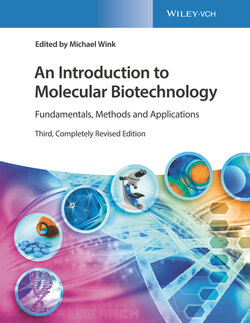Читать книгу An Introduction to Molecular Biotechnology - Группа авторов - Страница 41
4.1.3 Mitosis and Meiosis
ОглавлениеIn fertilization, an oocyte fuses with a spermatozoon; both cells became haploids during meiosis (Figure 4.7), therefore making the zygote a diploid. All other somatic cells undergoing mitotic division are also diploid. Only the gametes are haploid.
Figure 4.7 Schematic overview of mitosis and meiosis.
During mitotic cell division, the entire DNA is duplicated (replication); this results in two identical sister chromatids, which are held tightly together by a shared centromere (Figure 4.4). The condensed chromatids are pulled apart by the spindle apparatus, so that each new cell has a complete set of diploid chromosomes. In many eukaryotes, the phases of mitosis can be divided into distinct phases: prophase, metaphase, anaphase, and telophase.
Following the duplication of the chromosomes in the interphase nucleus (during S phase), the chromatin condenses to form discrete chromosomes in prophase (Figures 4.6 and 4.7), which consist of two identical chromatids. At the end of prophase and before the beginning of prometaphase, the nuclear membranes and nucleoli disappear; the nuclear spindle (consisting of polar microtubules and kinetochore microtubules) is formed. In prometaphase the microtubules attach themselves to the centromeres of the chromosomes with the help of special protein complexes (kinetochores) (Figure 4.4). The chromosomes are pulled by the microtubules (Figure 3.26) to the cell equator. In metaphase the chromosomes line up at the equator, and microtubules bind the centromeres with both spindle poles. In anaphase the kinetochore microtubules shorten, and therefore the chromatids are pulled toward each spindle pole. In the following anaphase II, the polar microtubules lengthen so that the cell begins to stretch. In telophase all of the daughter chromosomes are found at their corresponding spindle poles, the nuclear membrane reforms, and the nucleoli become visible again. At the same time, the polar microtubules push the cells further apart. Finally, in cytokinesis both daughter cells fully pinch off from one another; this results in two independent cells, each with an identical set of chromosomes.
In meiosis the sets of chromosomes are divided in half (reduction division), therefore resulting in the haploid genome. Meiosis is required for sexual reproduction in diploid organisms. If the gametes were diploid, every new zygote formed would contain double the number of chromosomes. This dilemma can only be solved through haploid gametes. Meiosis also serves to mix the paternal genes and increases genetic variability, which is an important prerequisite for natural selection.
The most important difference between meiosis and mitosis lies in the pairing of homologous chromosomes and the consequent reduction of the chromosome set. Meiosis is divided into two divisions: the first and second reduction division (or meiosis I and meiosis II). In prophase of the first reduction division, there are five stages: leptotene, zygotene, pachytene, diplotene, and diakinesis. After doubling of the chromosomes, two sister chromatids become apparent in the leptotene. In zygotene the pairing of the homologous maternal and paternal chromosomes begins (synapsis). The chromosomes paired in each case correspond to each other at the sequence level, enabling crossing‐over and recombination to take place. These processes enhance the exchange of genetic information from both parents. In pachytene the pairing of homologous chromosomes is completed. In the following diplotene the chromosome pairs separate from one another but cling together at the sites on which crossing‐over took place (so‐called chiasmata). In this phase, the chromosomes unwind and are transcriptionally active. In diakinesis the transcription ends, and the chromosomes condense again.
In the following metaphase I, the nuclear membrane and nucleolus break down, and the spindle apparatus is formed. The chromosome pairs assemble themselves on the equator so that the centromeres are orientated to the spindle poles. However, the kinetochore microtubules do not attach to the centromeres of individual chromatids (as in mitosis), but to a shared centromere of each chromatid pair. In meiotic anaphase I, the chromosome pairs are pulled apart over the shortening kinetochore microtubules to the cell poles. The recombinant chromosome areas separate at the chiasmata. The sister chromatids remain joined together via the centromere.
After a short interphase, the second reduction division occurs. This division contains the mechanics of mitosis. The chromosomes are ordered again as in metaphase: metaphase II. The chromatids are pulled apart by the kinetochore microtubules to the cell poles. This process is completed with anaphase II. After the telophase II and cytokinesis, haploid cells remain (so‐called meiospores or meiogametes), each with a haploid chromosome set available. During the formation of haploid gametes, the chromosomes from the parents are sorted randomly, which again increases genetic variability.
